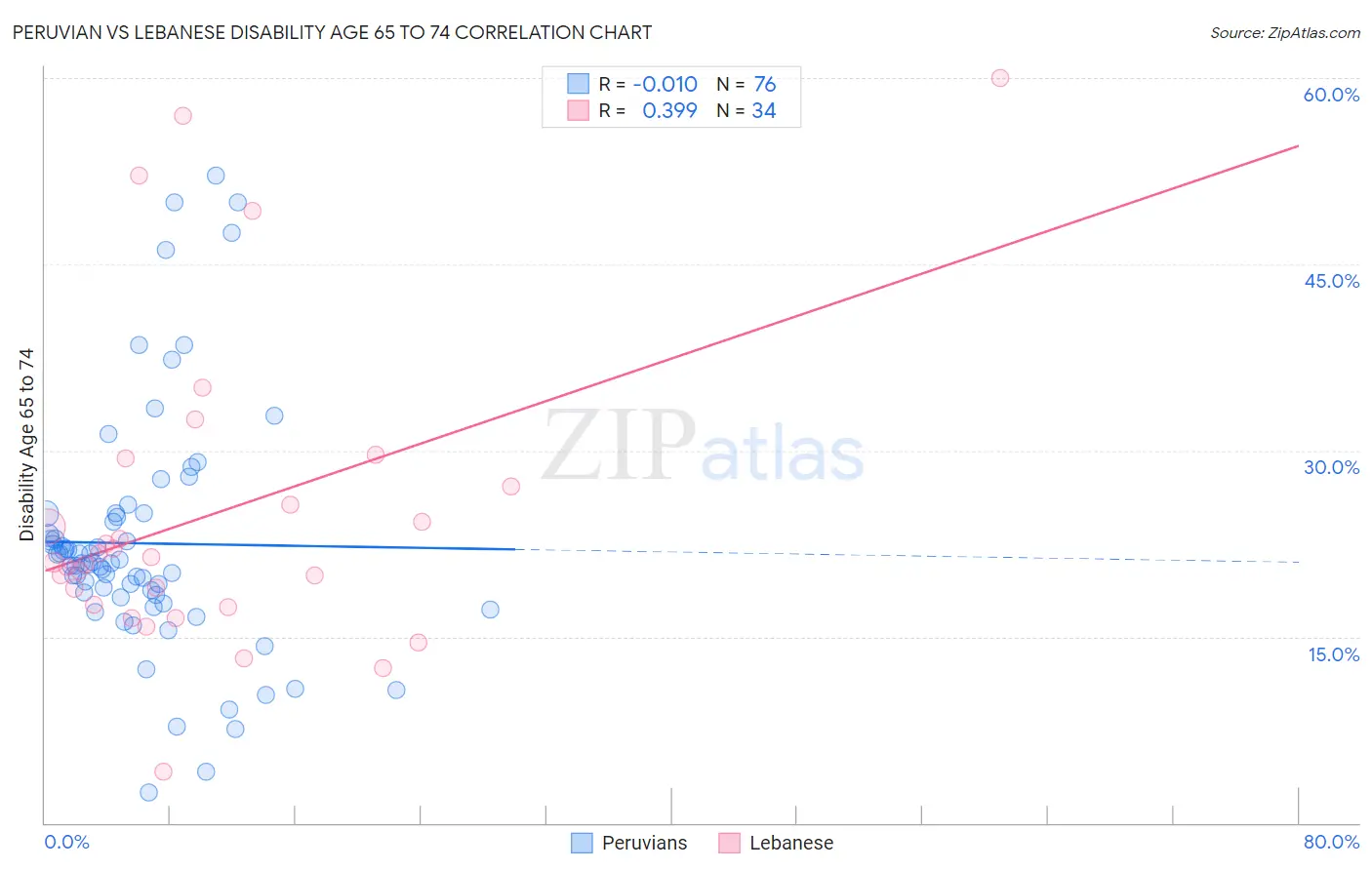Peruvian vs Lebanese Disability Age 65 to 74
COMPARE
Peruvian
Lebanese
Disability Age 65 to 74
Disability Age 65 to 74 Comparison
Peruvians
Lebanese
22.2%
DISABILITY AGE 65 TO 74
96.1/ 100
METRIC RATING
106th/ 347
METRIC RANK
22.5%
DISABILITY AGE 65 TO 74
92.2/ 100
METRIC RATING
126th/ 347
METRIC RANK
Peruvian vs Lebanese Disability Age 65 to 74 Correlation Chart
The statistical analysis conducted on geographies consisting of 362,491,372 people shows no correlation between the proportion of Peruvians and percentage of population with a disability between the ages 65 and 75 in the United States with a correlation coefficient (R) of -0.010 and weighted average of 22.2%. Similarly, the statistical analysis conducted on geographies consisting of 400,836,048 people shows a mild positive correlation between the proportion of Lebanese and percentage of population with a disability between the ages 65 and 75 in the United States with a correlation coefficient (R) of 0.399 and weighted average of 22.5%, a difference of 1.1%.

Disability Age 65 to 74 Correlation Summary
| Measurement | Peruvian | Lebanese |
| Minimum | 2.4% | 4.1% |
| Maximum | 52.2% | 60.0% |
| Range | 49.7% | 55.9% |
| Mean | 22.5% | 24.9% |
| Median | 20.9% | 21.2% |
| Interquartile 25% (IQ1) | 18.3% | 17.6% |
| Interquartile 75% (IQ3) | 24.8% | 27.1% |
| Interquartile Range (IQR) | 6.5% | 9.5% |
| Standard Deviation (Sample) | 9.8% | 12.6% |
| Standard Deviation (Population) | 9.7% | 12.4% |
Demographics Similar to Peruvians and Lebanese by Disability Age 65 to 74
In terms of disability age 65 to 74, the demographic groups most similar to Peruvians are Slovene (22.2%, a difference of 0.010%), Immigrants from Zimbabwe (22.3%, a difference of 0.020%), Albanian (22.3%, a difference of 0.11%), Immigrants from Peru (22.3%, a difference of 0.15%), and Serbian (22.3%, a difference of 0.17%). Similarly, the demographic groups most similar to Lebanese are Immigrants from Western Europe (22.5%, a difference of 0.020%), Norwegian (22.5%, a difference of 0.060%), Hungarian (22.4%, a difference of 0.25%), Czech (22.4%, a difference of 0.30%), and Immigrants from Jordan (22.4%, a difference of 0.30%).
| Demographics | Rating | Rank | Disability Age 65 to 74 |
| Peruvians | 96.1 /100 | #106 | Exceptional 22.2% |
| Slovenes | 96.1 /100 | #107 | Exceptional 22.2% |
| Immigrants | Zimbabwe | 96.1 /100 | #108 | Exceptional 22.3% |
| Albanians | 95.8 /100 | #109 | Exceptional 22.3% |
| Immigrants | Peru | 95.7 /100 | #110 | Exceptional 22.3% |
| Serbians | 95.7 /100 | #111 | Exceptional 22.3% |
| Immigrants | South America | 95.5 /100 | #112 | Exceptional 22.3% |
| Syrians | 95.3 /100 | #113 | Exceptional 22.3% |
| Ukrainians | 95.1 /100 | #114 | Exceptional 22.3% |
| Laotians | 94.9 /100 | #115 | Exceptional 22.3% |
| Brazilians | 94.8 /100 | #116 | Exceptional 22.4% |
| Swedes | 94.7 /100 | #117 | Exceptional 22.4% |
| Austrians | 94.7 /100 | #118 | Exceptional 22.4% |
| Immigrants | Northern Africa | 94.7 /100 | #119 | Exceptional 22.4% |
| Immigrants | Kazakhstan | 93.9 /100 | #120 | Exceptional 22.4% |
| Czechs | 93.5 /100 | #121 | Exceptional 22.4% |
| Immigrants | Jordan | 93.5 /100 | #122 | Exceptional 22.4% |
| Hungarians | 93.3 /100 | #123 | Exceptional 22.4% |
| Norwegians | 92.5 /100 | #124 | Exceptional 22.5% |
| Immigrants | Western Europe | 92.3 /100 | #125 | Exceptional 22.5% |
| Lebanese | 92.2 /100 | #126 | Exceptional 22.5% |